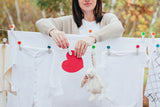Washing Newborn Clothes
One of the most important duties for parents is washing newborn clothes. Because the baby’s skin is delicate and sensitive and their immune system is not yet completely developed, washing newborns' clothes requires additional care and attention.
With so many materials and washing symbols, it can get overwhelming for parents. Parents need to watch everything when washing newborns' clothes, from the right detergents, washing cycles, color, and many other things.
So, having all of this in mind, you can ensure that your baby’s clothes are always clean, comfortable, and safe to wear by reading this article.

Source: shutterstock.com / Photo Contributor: StoryTime Studio
Washing Newborn Clothes
Welcoming a newborn baby into the world is an exciting moment for parents, and ensuring they are comfortable and safe is very important.
One of the parent's most important duties is washing the clothes before the baby wears them. Because the baby's skin is sensitive, washing newborn clothes requires additional care and attention.
Since babies have sensitive skin, it is important to use gentle, fragrance-free detergents and fabric softeners when washing their clothes. Washing the clothes separately from the rest of the family is also recommended, as it helps prevent exposure to potentially harmful chemicals.
Water temperature is another essential factor to consider when washing newborn clothes. Warm water, around 86-104 degrees Fahrenheit (30-40 degrees Celsius), is good enough to avoid damaging the fabric while effectively removing any dirt or stains. You should avoid hot water because it has the potential to shrink or damage some fabrics.
However, babies grow fast, and they often need new clothes. If you are looking for some newborn baby girl clothes, you can find them on our site.
Everything Required to Keep Your Newborn’s Clothes Spotless
There are several things to consider when washing baby clothes to ensure that your baby’s clothes are clean, soft, and safe for their sensitive skin.
Gentle Detergent
It is recommended to use a mild, fragrance-free detergent designed specifically for babies due to the baby’s sensitive skin. Harsh detergents can irritate the baby’s skin and cause rashes. Also, it would be better to avoid fabric softeners and bleach.
Stain Remover
Babies are messy, and their clothes can easily become stained with spit-up, food, or something else. You could use a stain remover before washing to handle the stains better.
If you don’t want to use a stain remover, another good option is to soak the stain in undiluted white vinegar for at least 30 minutes.
Washing Machine
A washing machine is essential for washing baby sloths. You should choose a machine with a gentle setting to protect the delicate fabrics of baby clothes.

Source: shutterstock.com / Photo Contributor: Stasia04
Drying Rack
A drying rack can be helpful if you prefer to air-dry your baby's clothes. When they are not in use, they can be folded up and stored away, and they are ideal for drying delicate items that can’t go in the dryer.
Dryer
A dryer can make washing baby clothes much simpler and faster, but using a low heat setting is important to prevent damage to the clothes.
Mesh Laundry Bags
Mesh laundry bags can help protect baby clothes from damage in the washing machine. You could use them to separate items by size or to keep delicate fabrics from tangling with other items.
Iron
When ironing baby clothes, using the lowest setting possible is recommended, and avoiding pressing directly on any prints or embellishments.
Storage
After washing, store the baby's clothes in a clean and dry place, away from direct sunlight or heat. You could use plastic bins or cotton bags to keep them organized and dust-free.
Tips on How to Clean Stubborn Stains
Babies are known for spitting up, rolling, and having diaper blowouts, which can leave some tough stains on their clothes. Washing newborn clothes requires a gentle touch and extra attention.
Treating stains immediately
The secret to removing stubborn stains from baby clothes is to treat them as soon as possible. The longer you wait, the harder it will be to remove the stain.
Therefore, when you notice a stain, rinse the clothes in cold water to remove as much as possible of the stain.
Here are some tips for removing specific types of stains from baby clothes:
Spit-up
Spit-up spots can be removed by rinsing the clothes in cold water and using a stain remover or pretreating the stain with a mixture of baking soda and water.

Source: shutterstock.com / Photo Contributor: Maryna_Auramchuk
Food stains and diaper accidents
Scrape any excess food or waste before rinsing the clothes in cold water to remove food stains. Before washing the clothes, use a stain remover or treat the stain with a baking soda and water mixture.
Formula stains
Formula stains are another common issue for parents. To remove these stains, start by rinsing them with cold water. Then apply a pretreatment solution and let it sit for a few minutes before washing the clothes in cold water.
If the stain is particularly stubborn, you can use a mixture of baking soda and water to make a paste and apply it before washing the clothes.
Methods for removing stains
Stain Remover
Many stain removers on the market are specifically designed to remove stubborn stains from baby clothes. You should look for a gentle stain remover on baby clothes that includes enzymes that break down the stain.
Soaking
If a stain is particularly stubborn, you may need to soak the clothes in a mixture of warm water and stain remover. Before doing this, follow the stain remover’s instructions carefully and avoid using hot water.
Baking Soda
Baking soda is a natural stain remover that can be useful in removing stubborn stains from baby clothes. Make a paste of baking soda and water, then apply it to the stain and let it sit for at least 30 minutes before washing the clothes as normal.
Vinegar
Another natural stain remover that can be effective for removing stains from baby clothes is vinegar. Mix equal parts of vinegar and water and apply the mixture to the stain. Let it sit for at least 30 minutes before washing the clothes as usual.
Washing in hot water
If the stain is very stubborn, the clothes may need to be washed in hot water. However, you should check the clothes care label first because some fabrics may not be able to withstand hot water.

Source: shutterstock.com / Photo Contributor: Simonov Stas
Bleach
While bleach can effectively remove stains, it can also damage delicate fabrics and cause discoloration. Unless the care label specifically recommends, avoid using bleach on baby clothes.
The Meaning of Wash Care Labels
Baby clothes are delicate and need special care to stay in good condition. Washing baby clothes can be tricky, especially for new parents who may not have previous experience with laundry care.
Because of that, washing symbols on wash care labels are a universal method for providing laundry instructions to customers. These symbols show the appropriate care and maintenance instructions for different fabrics and garments.
Understanding these symbols is essential, especially when washing baby clothes, so having that in mind, here is a breakdown of the most common washing symbols found on wash care labels and their meaning.
Hand wash symbol
This symbol looks like a bucket of water and has a hand, suggesting that the item should be washed by hand rather than washing it in a machine.

Machine wash symbol
A tub of water represents the washing symbol. The number inside the tub represents the highest temperature at which the clothes can be cleaned.
If there are two lines beneath the tub, it means you should wash the clothes on a gentle cycle. If there is an X through the tub, it means that you cannot wash the clothes, and they should be dry cleaned instead.

Drying symbol
A square represents the drying symbol. If there is a circle within the square, it means that the clothes can be tumble dried.
The number inside the circle represents the highest temperature at which the clothing can be dried.
A line beneath the square means the clothes should be dried gently. If the square has an X through it, the clothing should not be tumble dried at all.

Dry cleaning symbol
A circle represents the dry cleaning symbols. Sometimes in the circle, there could be a letter. The letter specifies the sort of solvent to be used for dry cleaning. For example, the letter A means the clothes should be dry cleaned with any solvent.
Moreover, if there is an X in the circle, it means that the clothes should not be dry-cleaned.

Ironing symbol
Iron represents the ironing symbol. The number on the inside of the iron shows the highest temperature at which clothes can be ironed. The clothes can be steamed if there are water drops beneath the iron.
The clothing should not be ironed if there is an X through the iron.

Why You Should Be Careful When Washing Baby Clothes
One of the most important aspects of baby care is ensuring their clothes are clean and safe. However, parents must be careful when using detergent on their baby’s clothes.
Here are some reasons why parents should be careful when washing their baby’s clothes:
- The baby's skin is more delicate and sensitive than an adult's. This makes them more prone to skin irritations and allergies. Detergents that contain harsh chemicals and fragrances can cause skin irritation, rashes, and even allergic reactions.
- Baby clothes need to be washed more frequently than adults. This is because babies spit up, drool, and leak diapers. Frequent washing can cause clothes to wear and tear, and harsh detergents can worsen it.
- Babies explore the world around them by putting things in their mouths. It is not unusual for them to chew on their clothes. Harsh chemicals in detergents can be harmful if consumed, possibly causing stomach upset.

Source: shutterstock.com / Photo Contributor: Tatevosian Yana
Conclusion
Washing newborn clothes can be difficult, but it can be a straightforward part of baby care with the right knowledge and techniques.
Because newborns have sensitive skin prone to irritation and rashes, you must thoroughly clean their clothing before use. Prioritizing the baby’s clothing care, you can create a healthy and clean environment for your little one.






